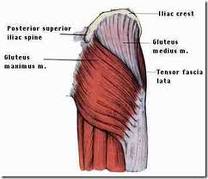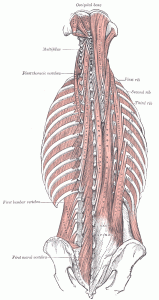A muscle is comprised of millions of fibers, in most cases running in the same direction. Each of these fibers has many ‘hooks’ along the length of the muscle. Muscles contract to create motion by using these hooks to grab the fiber next to it and pulling it closer thereby contracting the muscle. These hooks are released when the muscle is elongating. When muscles undergo long periods of contraction sometimes the hooks don’t let go. Many of these stuck spots build up to be knots we can all feel in our muscles when they are stressed. As a therapist I will use my fingers, knuckles, palm and elbow to pry those stuck fibers apart and allow the muscle to return to its resting state. This does not always happen easily and may take a few sessions before any great release takes place.
Since there are millions of fibers it is quite unlikely that all will be released during one session. Some of the stuck spots could be decades old and will take some time and mental fortitude to let go. Like layers of an onion I hope to peel off what will be allowed, going deeper and deeper with successive sessions. Since these tight muscles are used to being bound up in knots there is a tendency to recoil after experiencing release. It may take a few successive treatments to make substantial progress.
Most of our tension is concentrated in two major joints, the shoulder and the hip. Both of these joints are ball and socket joints. A ball in a socket has tremendous range of motion requiring a muscle to move in each direction possible. This means lots of muscles, some with multiple angles and purposes, and all overlapping each other. The shoulder joint consists of shoulder,upper back and neck muscles. The hip joint includes both lower back and gluteal muscles.
 The primary muscles of the shoulder joint are trapezius, levator, deltoids, and rhomboids. Trapezius is shaped like a triangle with one corner located at the base of the skull, one towards the top of the shoulder, and the last being at the bottom of the rib cage right along the spine. It also has multiple attachment sites along the spine from the base of the skull down to the base of the rib cage and multiple attachment sites along the clavicle and scapula. Nearly all shoulder movements require the trapezius. It also is a shoulder stabilizer used in activities like typing or driving. Levator runs from just behind the ear on the skull down to the inner top corner of the scapula(shoulder blade). It shrugs the shoulders. Most common source of tension in neck/shoulder. Rhomboids attach along the spine at just about the bottom of the neck and run to the lower/inner edge of the scapula. They bring the shoulders back and together used in any kind of pulling action. The muscles that surround the shoulder joint are the deltoids. These help lift the arm away from the torso, either front, back or side.
The primary muscles of the shoulder joint are trapezius, levator, deltoids, and rhomboids. Trapezius is shaped like a triangle with one corner located at the base of the skull, one towards the top of the shoulder, and the last being at the bottom of the rib cage right along the spine. It also has multiple attachment sites along the spine from the base of the skull down to the base of the rib cage and multiple attachment sites along the clavicle and scapula. Nearly all shoulder movements require the trapezius. It also is a shoulder stabilizer used in activities like typing or driving. Levator runs from just behind the ear on the skull down to the inner top corner of the scapula(shoulder blade). It shrugs the shoulders. Most common source of tension in neck/shoulder. Rhomboids attach along the spine at just about the bottom of the neck and run to the lower/inner edge of the scapula. They bring the shoulders back and together used in any kind of pulling action. The muscles that surround the shoulder joint are the deltoids. These help lift the arm away from the torso, either front, back or side.
 The glutes run from the sacrum(the base of the spine) and the top of the iliac crest out and down towards the upper, outermost portion of the thigh bone. They help in stepping up and rotating the leg outwards. They also help stabilize the hips by working in conjunction with the lower back muscles. There are three sections; gluteus maximus, gluteus medius, and gluteus minimus. Maximus is what makes up our butt. Medius and minimus run a little more vertical and lift the leg more to the side than back. The lower back muscles include the erectors and quadratus lumborum. The erectors are a group of muscle that keep the spine erect. They run the length of the spine in multiple sections with no one muscle traversing the entire spine. Many attachment sites along the spine and rib cage, close to the spine. More sites along the sacrum where our spine connects to our pelvic bone. Along the spine between the ribs and pelvis runs quadratus lumborum. One on each side of the spine, they work together to lean back and independently to lean to the side.
The glutes run from the sacrum(the base of the spine) and the top of the iliac crest out and down towards the upper, outermost portion of the thigh bone. They help in stepping up and rotating the leg outwards. They also help stabilize the hips by working in conjunction with the lower back muscles. There are three sections; gluteus maximus, gluteus medius, and gluteus minimus. Maximus is what makes up our butt. Medius and minimus run a little more vertical and lift the leg more to the side than back. The lower back muscles include the erectors and quadratus lumborum. The erectors are a group of muscle that keep the spine erect. They run the length of the spine in multiple sections with no one muscle traversing the entire spine. Many attachment sites along the spine and rib cage, close to the spine. More sites along the sacrum where our spine connects to our pelvic bone. Along the spine between the ribs and pelvis runs quadratus lumborum. One on each side of the spine, they work together to lean back and independently to lean to the side.


Tension comes from a variety of sources. Most commonly are physical; from unfamiliar physical labor or over-exertion, and psychological; from stress and anxiety. These stresses have a negative effect on our bodies if we do not allow enough rest to recover. Generally life is too busy to fully deal with these stimuli whether that be stretching or meditating or just plain resting. Our muscles never totally relax and recover, we just ignore the discomfort until it becomes background music.
Totally oblivious to the pain our bodies are in, these knots fester disrupting the flow of blood and energy through our body. Digging deep can unearth some very uncomfortable feelings and emotions. The pain associated with them can be intense. There is nothing to fear though, for when you face these uncomfortable feelings they begin to fade. The first time you run your legs will be sore and it will probably hurt a bit with each successive run getting easier and easier. So will dealing with intense fears and pains. They aren’t going anywhere until you do.
